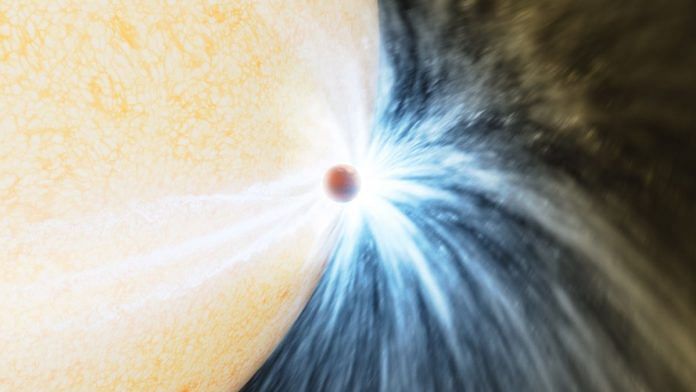New Delhi: Astronomers have for the first time observed a Sun-like star swallowing a planet in “one big gulp”, finally confirming a fundamental prediction about stars and their planets.
Earth, too, will meet a similar fate 5 billion years from now, according to the study, conducted by researchers at MIT in collaboration with Harvard University and Caltech and published in Nature Wednesday.
“Astronomy helps us answer where we are from in the universe and where we are going. This discovery has told us where we are going,” the study’s lead author, Kishalay De, said during a press briefing. De is a postdoctoral fellow at the Massachusetts Institute of Technology (MIT) Kavli Institute for Astrophysics and Space Research.
Stars expand as they evolve — powering luminous mass ejections as they do so — and thus scientists expect them to engulf planetary bodies close to them. But this has never been observed, until now.
This ageing star, ZTF SLRN-2020, completely engulfed one of its inner planets over a period of about 10 days. The latter was much bigger than the Sun’s inner planets — such as Mercury, Venus, or Earth — and approximately 10 times the mass of Jupiter, though only about 1/1,000th the size of the star. The incident took place 15,000 light-years away in the constellation Aquila, close to the galactic plane of the Milky Way.
The star suffered an outburst accompanied by bright, infrared emissions that slowly faded over the course of around six months. The researchers ran various models to better understand the properties of this optical outburst and its emissions.
While the outburst was similar to those associated with red novae — eruptions caused by two individual stars merging — it had a much lower luminous intensity. This hinted that it was actually a planet being engulfed by a star.
Alongside archival images, astronomers used a combination of telescopes to make these observations, which included the Zwicky Transient Facility (ZTF) at Caltech’s Palomar Observatory, the W.M. Keck Observatory, and NASA’s NEOWISE mission.
“The majority of planets will suffer this fate at the end of the star’s evolution,” said Morgan MacLeod, a postdoctoral fellow at the Harvard-Smithsonian Center for Astrophysics and one of the researchers on the project. “Stars have an atmosphere. And then planets which orbit around them can feel a drag force from it. This causes the orbit to tighten, and the star to engulf the planet.” These findings can help determine the fate of planets as stars evolve.
Also read: Two species of clam shrimps discovered in Goa & Karnataka. Here’s what sets them apart
An accident
De’s research started three years ago, when he was observing novae, which result in the sudden appearance of a bright and possibly new star. But this particular star, ZTF SLRN-2020, appeared to brighten immensely over a couple of weeks. De also noticed that it “ballooned” to four times its size, making the researchers question if this was just a nova, or something else.
“It seemed like the star ejected a lot of dust, which made it shine so brightly. It also ejected a lot of cold gas and at first, we thought this was a stellar merger. In a stellar merger, stars engulf other stars when they run out of fuel. But since it was much fainter compared to a stellar merger, we realised that it was a star engulfing a planet,” said De.
The Sun too, will slowly expand, first swallowing Mercury, then Venus and then Earth, too, about five billion years from now, the astronomers said. But by that time, Earth will have become inhospitable. “The Sun will also increase in power output, so all of the water on Earth will evaporate,” said MacLeod.
But the outer planets of the solar system may not see such a fate. MacLeod suggested that even as the Sun runs out of fuel and expands to a few hundred times its current radius, it will not be able to reach the outer planets.
Researchers note that whether a planet will ultimately be consumed by its star is dependent on certain conditions, and suggest that future observations of ZTF SLRN-2020 are still required.
(Edited by Zinnia Ray Chaudhuri)
Also Read: Scientists ‘read’ octopus minds for the first time, discover distinct brain activity patterns



